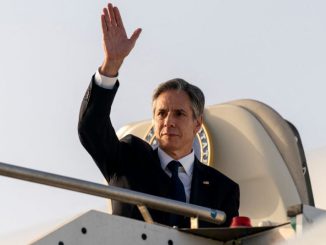

OAN’s Brooke Mallory
4:37 PM – Sunday, June 4, 2023
Saudi Arabia will reportedly be cutting back on the amount of oil it exports to the world economy in an effort to support the sagging price of crude after two earlier supply cuts by major oil-producing nations in the OPEC+ alliance failed to do so.
Advertisement
The other OPEC+ members also decided to extend earlier production cuts through next year during a conference in Vienna, which coincides with the Saudi Arabian cut of 1 million barrels per day set to begin in July.
At a press briefing, Saudi Energy Minister Abdulaziz bin Salman referred to the reduction as a “lollipop,” adding that “we wanted to ice the cake.” He stated that the cut might be prolonged and that the group “will do whatever is necessary to bring stability to this market.”
Jorge Leon, senior vice president of oil markets research at Rystad Energy, predicted that the new cut would likely increase oil prices in the short term, but that the long-term effect would depend on Saudi Arabia’s decision to extend it.
This decision provides “a price floor because the Saudis can play with the voluntary cut as much as they like,” he said.
“Gas is not going to become cheaper,” Leon said. “If anything, it will become marginally more expensive.”
The uncertainty surrounding the outlook for petroleum consumption in the upcoming months is highlighted by the Saudis’ belief that another cut is required. While there are worries about economic weakening in the United States and Europe, China’s recovery from COVID-19 restrictions has lagged below expectations.
One of the OPEC oil cartel’s major producers, Saudi Arabia, was among the countries to consent to a sudden decrease of 1.6 million barrels per day in April. The kingdom contributed $500,000. Following the announcement in October that it would cut 2 million barrels per day, OPEC+ threatened to raise gasoline prices a month before the midterm elections, which reportedly infuriated U.S. President Joe Biden.
In total, OPEC+ has reduced production by 4.6 million barrels per day on paper. However, several nations are unable to meet their limits, so the actual drop in supply is roughly around 3.5 million barrels per day, or more than 3% of it.
The past decreases did not significantly raise oil prices over time. Despite reaching a high of $87 per barrel, the international benchmark Brent crude price has since given up its post-cut gains and has been hovering around $75 per barrel. Recently, U.S. crude fell below $70.
As a result, according to the auto club AAA, gas prices in the United States are currently averaged at $3.55, $1.02 less than they were a year ago. The 20 European nations that use the euro saw their inflation rate fall to its lowest point before Russia’s invasion of Ukraine, thanks in part to declining energy prices.
In order to finance ambitious development initiatives intended to diversify the Saudi economy, the nation needs to maintain consistently high oil revenues.
According to the International Monetary Fund (IMF), the monarchy needs oil prices to be $80.90 per barrel in order to achieve its projected expenditure obligations, which include a $500 billion initiative to build a futuristic desert city called “Neom.”
An indicator that U.S. authorities may be less concerned about OPEC cuts than in the past several months was expressed by the recent decision to restock its Strategic Petroleum Reserve after Biden declared the largest release from the national reserve in American history.
While oil-producing nations like Saudi Arabia require cash to support their national budgets, they also need to consider how rising oil prices may affect oil-consuming nations.
Too-high oil prices can fuel inflation, reduce consumer purchasing power, and force central banks, like the U.S. Federal Reserve, to raise interest rates further. This, in turn, could further impede economic growth.
Saudi Arabia’s reduction in production and any rise in oil prices might boost the earnings that are assisting Russia in financing its conflict with Ukraine. As a result of Western sanctions intended to cut back on Moscow’s vital energy revenue, the country has discovered new oil consumers in India, China, and Turkey.
However, if crude prices rise above the $60 per barrel price cap imposed by the Group of Seven major democracies, it may complicate commerce for the world’s third-largest oil producer.
By using “dark fleet” tankers, which alter location data or transport oil from ship to ship to conceal its origin, Russia has discovered many ways to get around the price cap.
According to the OPEC+ agreement, Russian Deputy Prime Minister Alexander Novak said Moscow will maintain its voluntary cut of 500,000 barrels per day into the following year.
However, it is possible that Russia will not keep its promise. According to the International Energy Agency’s April oil market report, Moscow’s overall exports of crude oil and refined goods like diesel gasoline increased to a post-invasion high of 8.3 million barrels per day in the month of April.
Stay informed! Receive breaking news blasts directly to your inbox for free. Subscribe here. https://www.oann.com/alerts





Be the first to comment